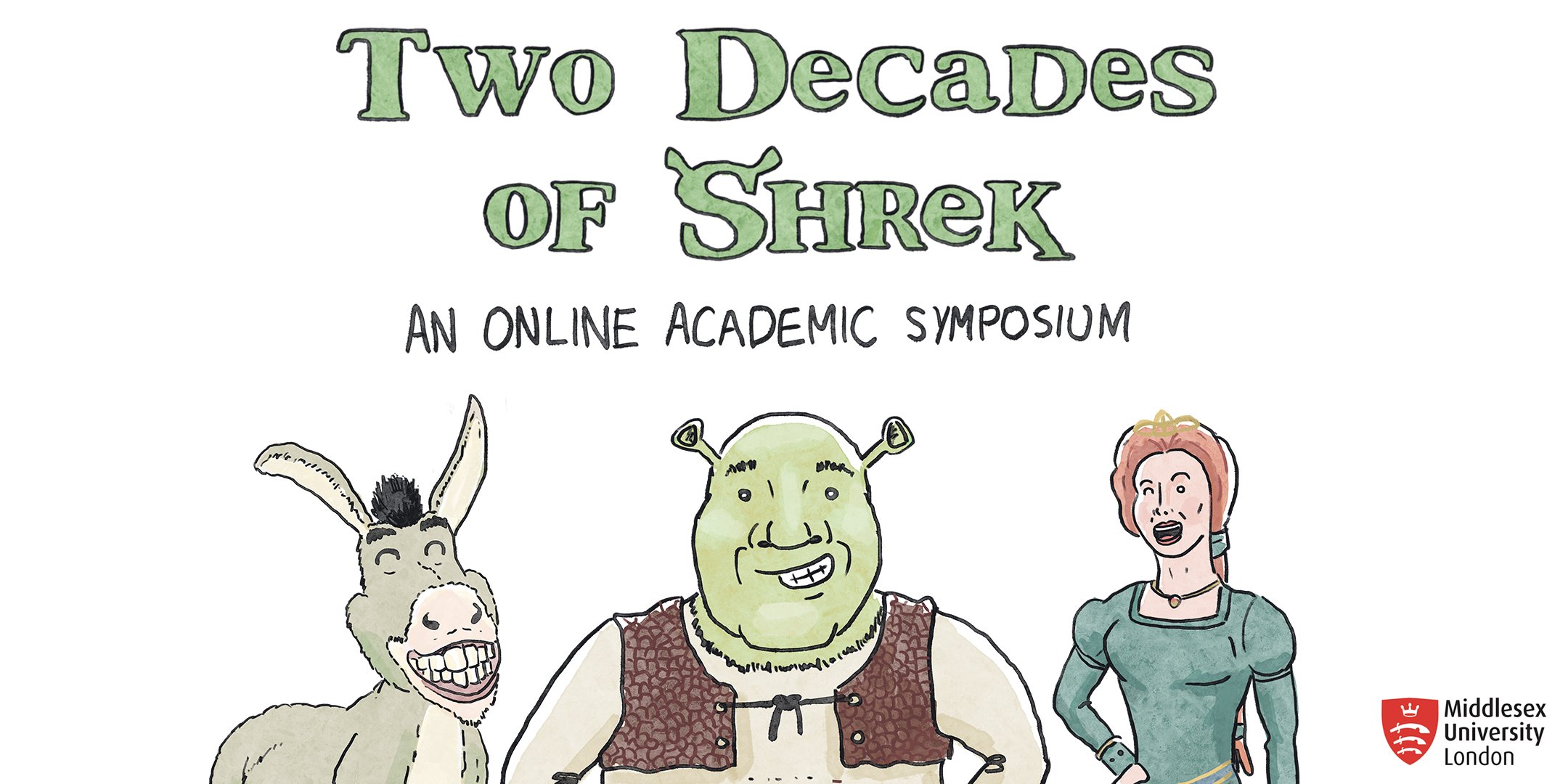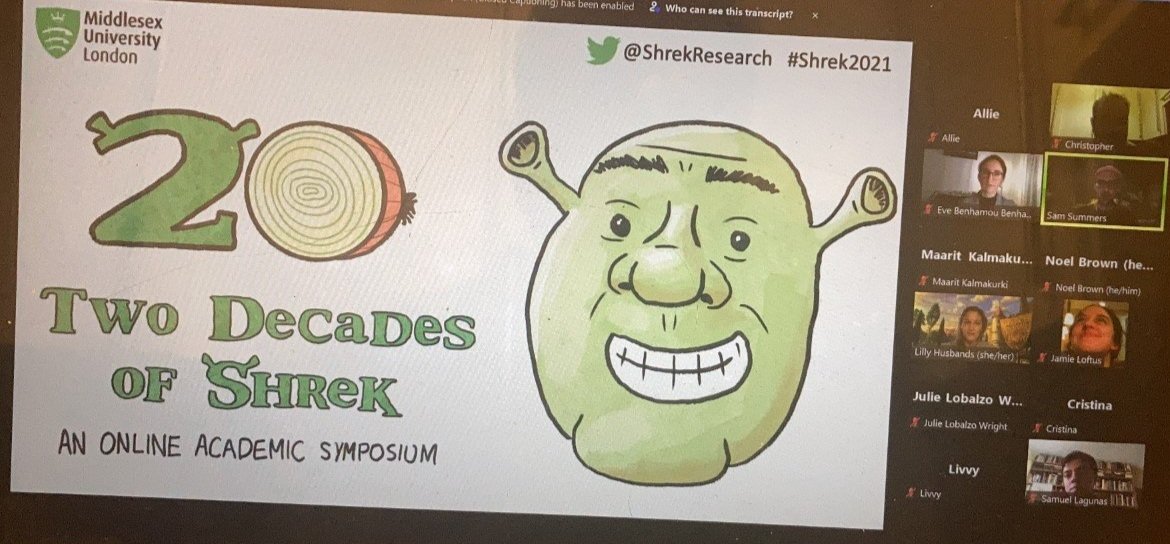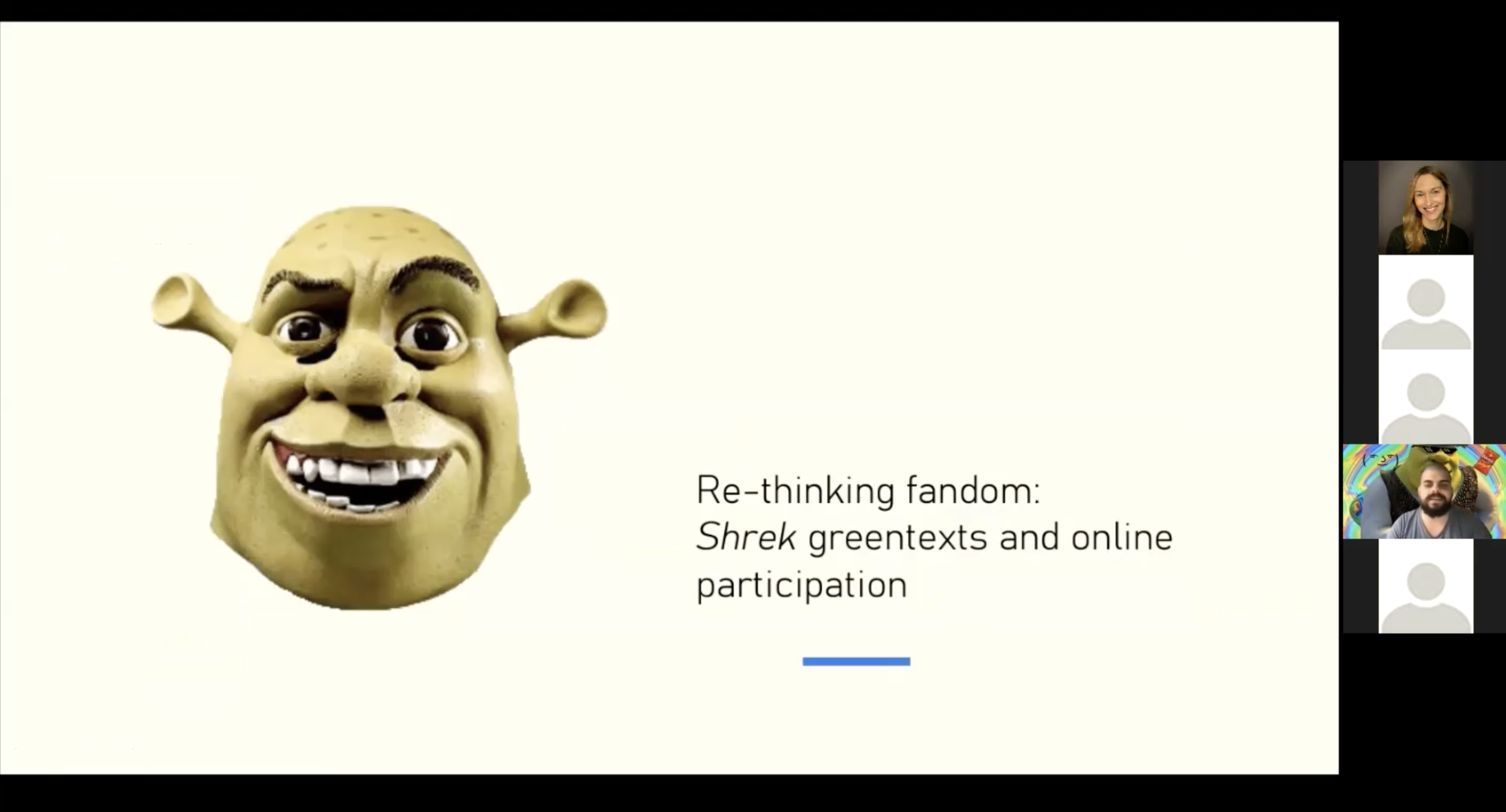Review: Two Decades of Shrek - An Academic Symposium
The well-rehearsed statement that animation is nothing more than a medium ‘for children’ that is ‘not taken seriously’ enough is troubling on two counts. Firstly, it is clearly an assumption that is wide of the mark, as anyone working in the fields of film, media, or animation studies will tell you. Secondly, it remains a statement overemployed as a default opening position across academia, often used by scholars to stake a claim for animation’s subsequent relevance and intrigue, as if any consideration of the medium would be unable to proceed without immediate justification of its occluded and marginalised status. Yet with the annual Society for Animation Studies conference due to enter its 33rd year in 2022, film festivals such as the recent Manchester Animation Festival rightly obtaining international visibility, practice-based courses popping up across U.K. Higher Education and beyond, and with a growing number of specialist and interdisciplinary animation journals continuing to spotlight the medium’s vibrant creative affordances, these calls for animation’s ongoing ‘critical sidelining’ as rationale for methodological enquiry perhaps hold less weight than they once did. One of the immediate advantages of the recent Two Decades of Shrek conference - held online on Saturday 13th November, and hosted by Middlesex University (Fig. 1) - was that it took its animated subject matter entirely seriously from the outset, rightly assuming popular culture as already relevant and worthy of scrutiny in ways that were refreshing as they were enlightening. Or, as cultural theorist Stuart Hall once put it, “Popular culture is one of the sites where this struggle for and against a culture of the powerful is engaged: it is the stake to be won or lost in that struggle. That is why ‘popular culture’ matters. Otherwise, to tell you the truth, I don’t give a damn about it” (1981, 239). Working on the basis that Shrek continues to ‘matter’, this one-day Zoom event (Fig. 2) was an outright celebration and interrogation of the film’s twenty-year anniversary, tracing its often vexed relationship to the Walt Disney studio, the film’s wider tonal influence upon the landscape of Hollywood animation, its ambivalent racial politics, and even its numerous online afterlives, to further secure (but also rightly take-for-granted) Shrek’s pop culture prowess.
Organised Dr. Sam Summers - author of DreamWorks Animation: Intertextuality and Aesthetics in Shrek and Beyond and recent Fantasy/Animation podcast guest for our episode on Shrek 2 (Andrew Adamson, Kelly Asbury & Conrad Vernon, 2004) - and Dr. Lilly Husbands (who in true online conference fashion beamed in from the 2021 CINANIMA - International Animated Film Festival of Espinho in Portugal), Two Decades of Shrek comprised an impressive roster of panels and speakers that evidenced precisely why we should ‘give a damn’ about DreamWorks 2001 computer-animated feature. Such was the diversity of topics that the conference’s schedule might have been organised in any number of ways, yet the four panels settled on were split between considerations of Shrek’s relationship to Disney and the U.S. commercial animation industry, questions of aesthetics and character/production design, identity politics and expectations around generic and gendered frameworks. The first paper from Dr. Amy M. Davis (University of Hull) (Fig. 3) in many ways set the tone of the debates that would follow during the course of the conference, insofar as Davis threaded the Shrek franchise through the question of formulaic storytelling and its ‘subversive’ tactics – two areas that accompanies critical and popular discussion of the tone and style of DreamWorks’ animated features, and notably, of course, Shrek. Davis argued that any ideological or artistic relationship between DreamWorks and Walt Disney should be viewed as altogether more ambivalent and fuzzier than previously understood, ultimately manifesting as both a simultaneous “rejection” and “borrowing” between studios, all the while supported by an industrial give-and-take as a backdrop to any mixing of formal properties related to the (re)telling of the fairy-tale film. Next up, Dr. Noel Brown (Liverpool Hope University) presented a paper that anchored Shrek both to the context of post-1990s/millennial Hollywood animation but also the concept of “relatability,” a term pervasive enough to warrant interrogation yet often considered uncritical and a label that lacks inherent value (Fig. 4). Brown argued for Shrek’s cultural position as a relatable text, a film that offers recognisable habits and characters, emotional realism and moral complexity, which contribute to a “quality of relatability” for children and young adults. He noted that among audience responses, Shrek was often held up as a transformative experience, replete with role models and messages in ways that show how “relatability” is a function of textual strategies collectively intended, as Brown put it, to “universalize the product” for audiences and/as consumers. Rounding off the opening panel was Dr. Eve Benhamou (University Paul-Valéry Montpellier 3), who revisited DreamWorks’ relationship to the Mouse House through a close(r) look at Disney’s feature film Tangled (Byron Howard & Nathan Greno, 2010), the studio’s first computer-animated fairytale and one that, for Benhamou, marked a commercial attempt to reappropriate the emergent DreamWorks formula (Fig. 5). This paper reminded me of the work of Marianne Vardalos (2011) who after the release of the final Shrek film coined a certain “Dreamworkification” of pop culture, and the ways in which the “hip” DreamWorks cartoon formula opened out new commercial possibilities for the animated feature. Yet moving through questions of critical parody, as well as Tangled’s paratexts and evident cartoonal mode, Benhamou gave us an exercise in expert cross-studio comparison and this Dreamworkification of Disney in practice, as well as a tantalising glimpse of the kind of work we can expect in her upcoming monograph on contemporary Disney animation.
The second panel kicked off with Maarit Kalmakurki’s (Aalto University) paper on costume and character in computer-animated features, bringing together – and crafting a dialogue between – costume design and animation as fields that have hitherto been kept as separate, but here in their union mobilised as a way of ‘thinking through’ the industry production and formal aesthetics of contemporary CG animation. Inspired by her doctoral dissertation, Kalmakurki cited the contribution of designer Isis Mussenden on several of the Shrek films, including her work on Shrek as the first animated feature to engage the work of a dedicated costume designer. This discussion of costume structures, design styles, and the reuse of virtual costumes within commercial production evidently holds clear implications for the discursive performance culture of animation, and how costume design can extend across (and be involved in) multiple spheres of labour within animated character creation. Shifting the focus from costume design to production design, Jodie Coates (University of Cambridge) (Fig. 6) explored the multiple books and bookshelves present in the Shrek films, implicating the bibliophilic quality of the franchise into broader debates concerning icons of literature and literacy. Showcasing some detailed archiving and textual analysis, Coates’ paper argued that the literary constitution of Shrek (the film is, after all, an adaptation) fosters a particular kind of active spectatorship as the hunt for embedded ‘easter eggs’ within media becomes a common viewing practice. Finally, Bence Bardos (University of Kent) (Fig. 7) confronted head-on Shrek’s post-cinema afterlife by focusing on the nuances of online participation, meme culture, and questions of fandom, looking at how Shrek (as an example of a beloved pop cultural icon) has been continually reworked and appropriated by a number of online fan communities. Looking at the Shrek is Love, Shrek is Life meme, Bardos examined audience participation as it unfolds across the poles of sincerity and irony, and how memes as a form of creative expression help to circulate cultural objects in meaningful ways.
Resuming after lunch, Panel 3 took as its main focus the ambivalent, and at times contradictory, identity politics that structure the Shrek franchise as a series highly pre-occupied with bodies, voice and difference. Jessica Gibson (University of York) examined the spectacle of unruly and unusual bodies through the lens of disability studies, tying Shrek’s representations of normalcy and monstrosity in ways that maintained and developed the theme of subversion as it played across each of the day’s panels. Gibson argued that as well as being co-opted into the stuff of narrative, bodily difference and presentations of diversity are central to how Shrek seeks to embrace new ways of thinking through stereotyped images of disability, as well as upturning longstanding connections between monstrosity and fear. Dr. Christopher Holliday (King’s College London) next examined the politics of race within the Shrek films released between 2001 and 2010 within two contexts related to a cultural blindness of colour (Fig. 8). Firstly, that the normalisation of a ‘post-racial’ refrain (largely across the U.S.) in the lead up to Barack Obama’s election in 2009 as the first person of colour to hold Presidential office, and secondly, connecting up Eddie Murphy’s vocal performance as the Donkey to more recent discourses of colourblindness and, ultimately, colourblind or aversive racism, and how a failure to see institutional or systemic structures of privilege and discrimination (all the while being framed as a positive step away from racism) link to Shrek’s so-called “racialised anthropomorphism” (King, Lugo-Lugo & Bloodsworth-Lugo 2009, 168). The final paper of the panel from Dr. Julie Lobalzo-Wright (University of Warwick) looked more closely at another vocal performance, this time Mike Myers as the eponymous Shrek, and in particular the accented Scottish voice of Myers in relation to the performer’s star persona and career trajectory (Fig. 9). Lobalzo-Wright traced Myers’ career as a comedian on Saturday Night Live (1975-) through to the Austin Powers series (Jay Roach, 1997-2003), connecting his many big and small screen roles to Steve Seidman’s (1981) writing on “comedian comedy,” but also positioning Shrek-as-star in ways that really usefully tapped into debates surrounding animation’s relationship to stardom (see Lobalzo-Wright [2019]), but also the importance of the star voice more broadly.
The conference’s final panel contained just two papers – one from Olivia Friend-Spencer (a recent graduate from Utrecht University) on the multivalent actions associated with “loving” and “being loved” animated throughout Shrek, and the other from Samuel Lagunas (Universidad Nacional Autónoma de México UNAM), who similarly concentrated his discussions on Princess Fiona, and in particular the character’s connection to the film’s portrayal of love in relation to (and as a form of) social rebellion. Friend-Spencer began the panel by noting that love, like ‘humanity’, is not always accessible or available to all, and that the Shrek films operate to identify how the romantic entanglement between ogre and human represents an intriguing mixing or ‘catching’ of identities. Within these normalised forms of kinship, the eponymous ogre also, for Friend-Spencer, embodies certain archetypes of masculinity that invite discussions of both ‘othering’ and the wielding of power. As Lagunas continued in the day’s final paper, the Shrek films are rife with images of bodies under duress and in transformation, and in the case of Fiona, a body whose physicality and agency positions her as rebellious and reactive, but also ultimately in line with societal expectations of womanhood. Culminating the conference’s persistent angle of subversion, Lagunas argued that Fiona’s (voluntary?) entrance into motherhood in Shrek 2 distances the character from her portrayal in the 2001 original, particularly in how the sequel reduces her rebelliousness and instead confers upon her a more heteronormative and conservative understanding of her role as mother.
In an era of screen fatigue where online conferences run the risk (maybe?) of creating an intellectual environment of sporadic engagement and intermittent energies, the ‘all star’ Two Decades of Shrek was an exercise in what you can do with focused industrial, ideological, and aesthetic analysis, and the benefits of an event shaped around the beginnings, middles, and endings of an individual case study film. Expertly organised and chaired in what can otherwise be a challenging virtual environment (so kudos to Sam and Lilly on that front), there were some impressive cross-pollinations happening live between papers without the kinds of critical repetitions that can sometimes impact an event that is so tightly focused on a singular text. But the Shrek films are, of course, far from singular anyway, and not just because of the tentacular reach of the franchise that unfolds across multiple ancillary and transmedia products. Rather, Shrek’s plurality became no less evident with each of the papers as the many perspectives in play throughout the conference began to push the film - and the series as a whole - out into other disciplinary fields, showing the possibilities and horizons for a film that has certainly had its detractors as well as, thankfully, its defenders (including Sam’s recent celebration of the film).
In short, this one-day Shrek event – like onions – certainly had some provocative and highly stimulating layers.
**Article published: November 26, 2021**
References
Hall, Stuart. 1981. “Notes on deconstructing ‘the popular’.” In People’s History and Socialist Theory, ed. Raphael Samuel, 231-235, 237-239. London: Routledge.
King, C. Richard, Carmen R. Lugo-Lugo, and Mary K. Bloodsworth-Lugo. 2009. Animating Difference: Race, Gender, and Sexuality in Contemporary Films for Children. Lanham: Rowman & Littlefield.
Lobalzo-Wright, Julie. 2019. “Animation and the Star Body.” Film/Philosophy 23, no. 2 (Special Issue on Stardom and Philosophy, ed. Lucy Bolton): 194-211.
Seidman, Steve. 1981. Comedian Comedy: A Tradition in Hollywood Film. Ann Arbor: UMI Research Press.
Vardalos, Marianne. 2011. “Kantian Cosmopolitanism and the Dreamworkification of the Next Generation.” In Investigating Shrek: Power, Identity, and Ideology, eds. Tim Nieguth, Aurélie Lacassagne and François Dépeltea, 80-102. New York: Palgrave Macmillan.
Biography
Christopher Holliday is Lecturer in Liberal Arts and Visual Cultures Education at King’s College London, where he teaches Film Studies and Liberal Arts and specializes in Hollywood cinema, animation history and contemporary digital media. He has published several book chapters and articles on digital technology and computer animation, including work in Animation Practice, Process & Production and animation: an interdisciplinary journal (where is also Associate Editor). He is the author of The Computer-Animated Film: Industry, Style and Genre (Edinburgh University Press, 2018), and co-editor of the collections Fantasy/Animation: Connections Between Media, Mediums and Genres (Routledge, 2018) and Snow White and the Seven Dwarfs: New Perspectives on Production, Reception, Legacy (Bloomsbury, 2021). Christopher is currently researching the relationship between identity politics and digital technologies in popular cinema, and can also be found as the curator and creator of www.fantasy-animation.org.













In Fairy Tales of London, Hadas Elber-Aviram traces the way in which eight British authors combine London and the fantastic in various stories. Elver-Aviram argues that the fictions of Charles Dickens, H. G. Wells, George Orwell, Mervyn Peake, Michael Moorcock, M. John Harrison, Neil Gaiman, and China Miéville form a coherent, socially engaged, literary tradition that is intimately connected to modern urbanity.